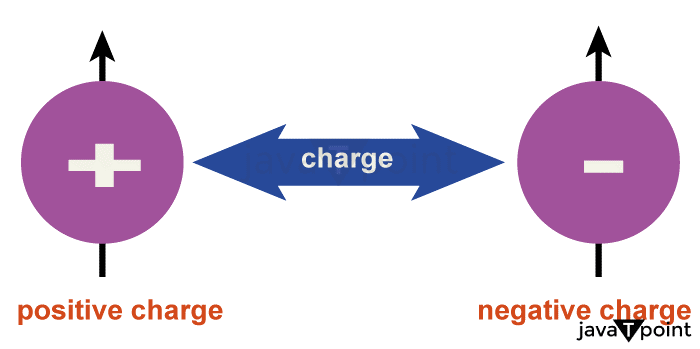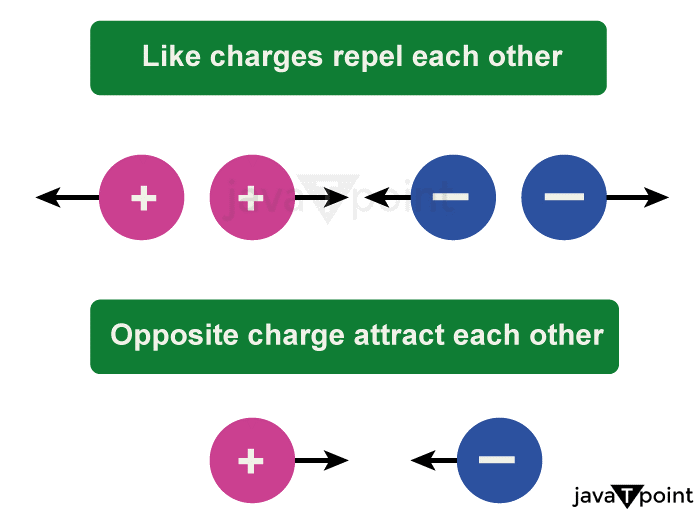-
 Home
Home -
 Python
Python -
 Java
Java -
 JavaScript
JavaScript -
 HTML
HTML -
 SQL
SQL -
 PHP
PHP -
 C#
C# -
 C++
C++ -
 DS
DS -
 Aptitude
Aptitude -
 Reasoning
Reasoning -
 Selenium
Selenium -
 DBMS
DBMS -
 C
C -
 Andriod
Andriod -
 Interview Q
Interview Q
next → ← prev Charge Definition PhysicsWhat Is Charge?A charge is a basic feature of matter that, according to physics, governs how particles interact. It is an electrical characteristic measured in units called Coulomb (C) and can be either positive or negative.  A charge may be defined as an object's ability to attract or repel other charged items. A positively charged object, for instance, will draw another positively charged object away while repelling a negatively charged thing. Charges can move between things, resulting in an electric current, a movement of charged particles. It is possible to use this stream of charged particles to power various electrical gadgets. Charged objects and particles generate electric fields. These fields, responsible for the interactions between charged objects, may also be used productively in devices like electric motors. Origin of ChargeIn physics, the idea of charge has a lengthy and intricate history. The ancient Greeks, for example, were aware that some materials might attract or repel one another when they were rubbed together. Still, they needed a logical methodology to understand why this happened. It was in the 18th century that electric charges began to make sense. Charles-Augustin de Coulomb, a French scientist, tested the inverse square law of electrostatic attraction, which says that the force between two charged objects is inversely proportional to their square of the distance and proportionate to the product of their charges. Coulomb's experiments led to the development of electrostatics, which examines the behavior of resting charges. However, French scientist Charles-Augustin de Coulomb was one of the important players in the early understanding of electric charge. Coulomb's most well-known work pertains to electrostatics, which examines the conduct of static electric charges. In the late 18th century, Coulomb conducted several experiments to test the law of inverse squares of electrostatic attraction, which indicates that the force between two charged objects corresponds to the product of their charges and is inversely proportional to the square of the distance between them. The science of electrostatics was developed due to Coulomb's experiments, and it is still a vital area of study today. The Coulomb (C), a unit of electric charge in the International System of Units (SI), bears his name in honor of his contributions to physics. But physicists started comprehending the connection between electric charges and currents in the 19th century. Hans Christian Oersted, a Danish scientist who discovered in 1820 that a magnetic field could cause a nearby compass needle to be deflected, was one of the important pioneers in this breakthrough. This made it apparent that electric currents and vice versa produce magnetic fields. The electron, a subatomic particle with a negative charge, was discovered in the latter half of the nineteenth century. This was yet another important development. Due to this, the theory of electromagnetism, which combined magnetic and electric phenomena into a single framework, was developed. Our knowledge of charge today is based on the standard model of particle physics, which covers the behavior of basic particles, including electrons, protons, and neutrons. According to this theory, the interaction between particles and electric and magnetic fields is governed by a basic feature of particles known as electric charge. Particle physics research is still being done on the cause of this charge. Many physicists contributed to the evolution of electric charges over time.  Roles of Charges in PhysicsMany branches of physics, such as electrostatics, electrodynamics, and quantum mechanics, depend critically on electric charges. These are some of the major functions that charges perform:
Charge's Nature and Characteristics
Basic Characteristics of ChargeThe underlying makeup of charge is a challenging subject that scientists are working to comprehend completely. However, according to what is known now, it is thought that subatomic particles like electrons and protons have charged as a characteristic. Protons are positively charged particles found inside an atom's nucleus, whereas electrons are negatively charged particles that circle the nucleus of an atom. A proton's and electron's charges have the same magnitude but different signs. Also found inside the nucleus are neutrons, which have no charge. Scientists are currently investigating the precise nature of the charge, but they have put out several proposals to explain its fundamental makeup. According to one hypothesis, charge results through the interchange of virtual photons, which are electromagnetic force carriers. It is also possible that a field that penetrates the entire universe and interacts with charged particles has the attribute of charge. By considering mathematical equations and models, the behavior of charge may be defined and predicted regardless of its precise composition, and the same can be used to process further for usage. A charge is vital to our comprehension of the natural world and is key to various scientific processes, such as electricity, magnetism, and electrochemistry. Behavioral Aspects of ChargeOne of matter's basic properties, electric charge, is essential to many physical events. This part will examine how charge behaves in various situations and states.
Generation of ChargeWe have to understand the structure of atoms to comprehend how the charge is produced. Atoms are made up of protons, neutrons, and electrons. Protons have a positive charge, neutrons have no charge, and electrons have a negative charge. The protons and neutrons are in the atom's nucleus, and the electrons orbit around it. An atom becomes charged when one or more electrons are added or removed. For instance, if an atom adds one electron, it changes its charge since it now has more electrons than protons and is thus negatively charged. One atom becomes positively charged if one electron is lost because it has fewer electrons than protons. A substance may interact with other charged things once it has a net charge. While opposing charges attract one another like charges repel one another. This interaction is governed by Coulomb's law, which states that the force between two charged objects is inversely proportional to their separation and proportionate to the product of their charges. Charged particles in motion can produce electric currents. The movement of charged particles through a medium, such as electrons, is an electric current. A voltage differential between two places in a circuit might cause this charge flow. Voltage, produced by the movement of charge, measures the electric potential energy per unit charge. Magnetic fields also have an impact on the mobility of charged particles. A force perpendicular to the magnetic field and the charged particle's velocity is experienced when the charged particle travels through a magnetic field. The Lorentz force law, which says that a charged particle experiences a force proportionate to its charge, velocity, and magnetic field strength, describes this force. ConclusionA key part of many physical processes is played by the basic feature of matter known as electric charge. It can be positive or negative and is produced by the motion of charged particles. According to Coulomb's law, opposing charges attract one another while like charges repel one another. The rules of electromagnetism, which explain the interplay between electric and magnetic fields, control the behavior of charged particles in motion. An electric current, the movement of charged particles through a medium, can be produced when charged particles are in motion. Numerous branches of science and technology, such as electronics, electromagnetism, plasma physics, and quantum mechanics, all depend on our knowledge of electric charge. Next Topic Circumference Definition ← prev next → |











玻璃钢生产厂家深圳玻璃钢花盆花器玻璃钢花盆行情安徽玻璃钢仿铜雕塑定制成都组合式玻璃钢花盆静香玻璃钢雕塑厂家玻璃钢雕塑的有点玻璃钢蚂蚁雕塑代理商江苏镜面玻璃钢雕塑价格行情河南室内雕塑玻璃钢聊城景区玻璃钢雕塑厂家如皋玻璃钢雕塑设计双流玻璃钢雕塑厂湛江人物玻璃钢雕塑山东玻璃钢动物雕塑厂家报价玻璃钢造型雕塑报价商场美陈材料玻璃钢校园雕塑价格湖北玻璃钢熊猫雕塑厂家温州艺术商场美陈商业商场美陈报价安阳玻璃钢卡通雕塑厂家玻璃钢卡通公仔人物雕塑浙江商业商场美陈供应商辽宁玻璃钢孔子雕塑制作玻璃钢花盆厂家联系方式北京城市标志玻璃钢雕塑商场秋季美陈网湖南玻璃钢彩绘雕塑制作厂家芜湖商场周年美陈红色文化玻璃钢雕塑香港通过《维护国家安全条例》两大学生合买彩票中奖一人不认账让美丽中国“从细节出发”19岁小伙救下5人后溺亡 多方发声单亲妈妈陷入热恋 14岁儿子报警汪小菲曝离婚始末遭遇山火的松茸之乡雅江山火三名扑火人员牺牲系谣言何赛飞追着代拍打萧美琴窜访捷克 外交部回应卫健委通报少年有偿捐血浆16次猝死手机成瘾是影响睡眠质量重要因素高校汽车撞人致3死16伤 司机系学生315晚会后胖东来又人满为患了小米汽车超级工厂正式揭幕中国拥有亿元资产的家庭达13.3万户周杰伦一审败诉网易男孩8年未见母亲被告知被遗忘许家印被限制高消费饲养员用铁锨驱打大熊猫被辞退男子被猫抓伤后确诊“猫抓病”特朗普无法缴纳4.54亿美元罚金倪萍分享减重40斤方法联合利华开始重组张家界的山上“长”满了韩国人?张立群任西安交通大学校长杨倩无缘巴黎奥运“重生之我在北大当嫡校长”黑马情侣提车了专访95后高颜值猪保姆考生莫言也上北大硕士复试名单了网友洛杉矶偶遇贾玲专家建议不必谈骨泥色变沉迷短剧的人就像掉进了杀猪盘奥巴马现身唐宁街 黑色着装引猜测七年后宇文玥被薅头发捞上岸事业单位女子向同事水杯投不明物质凯特王妃现身!外出购物视频曝光河南驻马店通报西平中学跳楼事件王树国卸任西安交大校长 师生送别恒大被罚41.75亿到底怎么缴男子被流浪猫绊倒 投喂者赔24万房客欠租失踪 房东直发愁西双版纳热带植物园回应蜉蝣大爆发钱人豪晒法院裁定实锤抄袭外国人感慨凌晨的中国很安全胖东来员工每周单休无小长假白宫:哈马斯三号人物被杀测试车高速逃费 小米:已补缴老人退休金被冒领16年 金额超20万